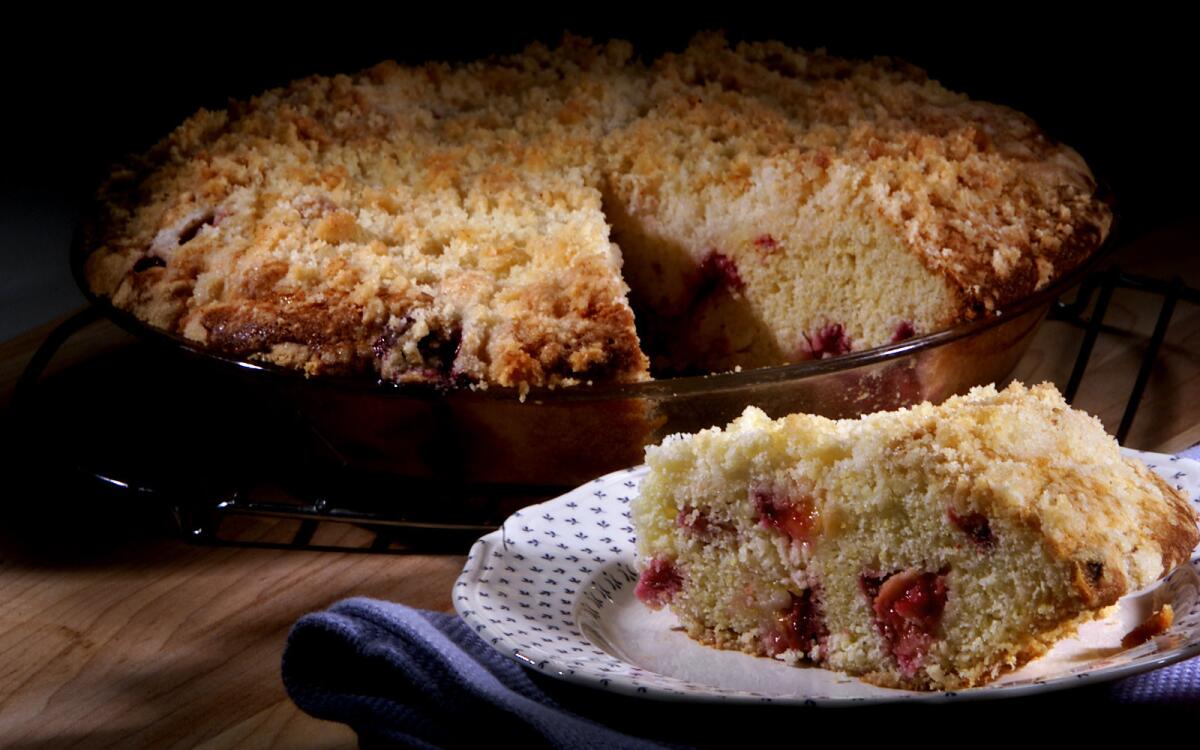Cornmeal buckle with plums

A perfectly ripe plum of the perfect variety, harvested on the perfect summer day, shipped and stored in the perfect way and delivered to you when you are in the perfect frame of mind to enjoy it--this is a rare pleasure indeed.
When you hit upon this set of circumstances, there’s only one thing to do. Rinse this heavenly fruit under cold running water; gently pat it dry, then lean far out over the sink and gobble it in huge, dripping bites. Anything else is superfluous.
But for even the canniest fruit picker, this confluence of perfect circumstances comes only a couple of times a summer. So what are you supposed to do when the fruit gods haven’t delivered perfect plums?
Cookbooks, oddly enough, aren’t much help. Plum recipes are even scarcer than perfect plums. Even the sources that are usually most reliable include only a couple--most ignore them altogether.
The situation is so extreme it borders on the conspiratorial. There is not one single dish that uses plums in the “Joy of Cooking.” Nor was there one in an old “Fannie Farmer” I checked, or in Madeleine Kamman’s “The Making of a Cook.” As usual, Julia Child can be relied upon--there are two recipes in “Mastering the Art of French Cooking.” That’s a bounty by plum standards.
The new “Chez Panisse Fruit” cookbook, so admirable in so many ways, adds insult to this grievous injury. Of the seven recipes included in the plum chapter, three are for prunes!
cComments
Got something to say? Start the conversation and be the first to comment.
ADD A COMMENT
0
It’s hard not to take it personally, and in fact, maybe that’s exactly what it is. Plums, like certain people, are a little too, well, definite for easy appreciation. While peaches and pears, apples and strawberries are pleasantly convivial, lending themselves to all sorts of endeavors, plums are acerbic. They are tart, often nearly to the point of astringency. There is no mistaking a dish that contains plums; no “Oh, this is nice, what is it?” When you’re served a plum dessert, you know it.
But since when was assertiveness a bad thing? While plums may be out of favor with those who prefer their fruit sweet and easygoing, they are magical when combined with ingredients confident enough to hold their own.
Plums are also a great boon to cooks. They don’t need to be peeled (indeed, much of the pucker is in the peel--removing it will make them sweeter, but less plum-like). You can just whittle them straight into the mixing bowl. Best of all, unless a plum is really ripe, it will have a near-perfect balance of pectin, sugar and acidity--it’ll turn to jam at a hot glance, no need for thickeners.
There are two ways to deal with their assertive nature: either complement it, or play against it. (Though there are hundreds of plum varieties and they come in different colors, for the purposes of recipes, they’re pretty much interchangeable.)
To complement a plum, think of things it tastes like. Cotes du Rhone, the big red wines from Southern France, are usually described as “plummy,” but other common adjectives are “spicy” and “peppery.” Plums not only do well poached in red wine, they are also improved by a generous hand with cloves, cinnamon and even black pepper. (Rhones are also frequently described as “leathery” but, somehow in a dessert, this does not appeal.)
Plums also play well with almonds. This is only reasonable, since they’re both members of the drupe family of fruits. The likeness is more than hereditary. The browned, buttery flavor of toasted almonds rounds out and lends warmth to the fruit’s tart personality.
You can also go the other way, using flavors that are definite enough to stand toe to toe with plums without backing down. Be cautious here: While assertiveness is needed, if it’s not carefully considered you could wind up with strong flavors that do nothing but clash--an Albee play in a dessert bowl.
The combination of cornmeal and plums is a particularly apt example of how this competition can work. A bit of cornmeal in waffles, crepes or cake batters adds both old-fashioned grainy sweetness and a faint trace of lingering bitterness that brings out the best in plums.
And somehow, no matter the dessert, a little bit of plain old vanilla ice cream or lightly sweetened creme fraiche smoothes out even the tartest plum. Think of it as soothing balm for a troubled fruit.
Topping
In a food processor, pulse together the sugar, flour, salt and butter until the pieces are the size of coarse crumbs.
Cornmeal buckle
Heat the oven to 350 degrees. Butter a 9-inch glass pie plate and set aside.
In a large bowl, sift together the flour, cornmeal, baking powder and salt.
In another large bowl, beat the 1/4 cup of butter with the sugar and egg until it is fairly light and fluffy. Add half of the milk and beat until smooth. Gradually add the remaining milk while beating.
Stir the dry ingredients into the wet ingredients just until well moistened. It will be the texture of cake batter. Fold in the plum pieces. Pour the batter into the pie plate and spread evenly. Scatter the topping mixture evenly over the top. Bake until the top is golden brown and a toothpick inserted in the center comes out clean, about 45 minutes.
Remove from the oven and let stand 20 minutes before serving. (If you serve the buckle the next day, warm it briefly in the microwave before serving.)
Get our Cooking newsletter.
Your roundup of inspiring recipes and kitchen tricks.
You may occasionally receive promotional content from the Los Angeles Times.
















